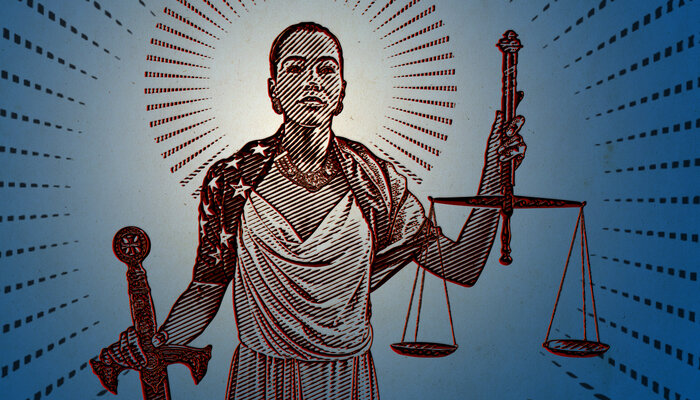Part of
In July 2019, the Brennan Center for Justice published State Supreme Court Diversity, which detailed vast racial, ethnic, and gender disparities on state high courts across the country, drawing on more than 60 years of data. This analysis updates the report with new data on the composition of state supreme courts as of April 6, 2021.1 It includes more detailed demographic information and, for the first time, information about justices’ professional backgrounds. The report was previously updated in February 2020.
Key findings since our last update include:
- In 22 states, no justices publicly identify as a person of color, including in 11 states where people of color make up at least 20 percent of the population.
- There are no Black justices in 28 states.
- There are no Latino justices in 40 states.
- There are no Asian American justices in 44 states.
- There are no Native American justices in 47 states.
- Across all state high courts, just 17 percent of justices are Black, Latino, Asian American, or Native American. By contrast, people of color make up almost 40 percent of the U.S. population.
- Women hold 39 percent of state supreme court seats.
- In 12 states, there is only one woman on the supreme court bench.
- Over a third (37 percent) of sitting justices are former prosecutors, while only 7 percent are former public defenders.
Recent Changes
Since we last collected data, in February 2020, there have been personnel changes involving 46 seats on state supreme court benches across the country: 41 new justices have taken office, and 5 seats are currently vacant.
There has been relatively little change in overall court demographics. Of the seats that have had personnel changes, 13 were filled via election and 28 via appointment. Thirty of the new justices are white (17 men and 13 women), including in 17 states where people of color make up at least 20 percent of the population (Alaska, Arkansas, Colorado, Connecticut, Florida, Georgia, Hawaii, Illinois, Kansas, Louisiana, Michigan, Minnesota, Nevada, North Carolina, Ohio, Rhode Island, and Texas). Of the remaining seats, four were filled by Black women, one by an Asian American woman, two by Latina women, three by Black men, and one by a Latino man. Nationally, the percentage of justices of color increased by two points since 2019, from 15 percent to 17 percent. The percentage of female justices increased by three points, from 36 percent to 39 percent.
Notable Changes
Rhode Island. On January 11, 2021, Melissa Long was sworn in as a justice on the Rhode Island Supreme Court, becoming the state’s first Black justice. Prior to Long’s appointment, Rhode Island never had a justice of color on its high court. Long was nominated by then-Gov. Gina Raimondo (the current U.S. secretary of commerce) and confirmed by the Rhode Island General Assembly. Previously, Long was an associate justice on the Rhode Island Superior Court from 2017 to 2020. With Long’s appointment, there are now 11 states in the country that have never had a person of color on their high court and 16 that have never had a Black justice.
California. Martin Jenkins was confirmed to the California Supreme Court by the state’s Commission on Judicial Appointments in November 2020 after being nominated by Gov. Gavin Newsom. Jenkins is the state’s first openly gay justice as well as its third Black justice. Prior to his appointment, a Black man had not served on the California Supreme Court in nearly three decades. Notably, Jenkins previously served as a judge on the U.S. District Court for the Northern District of California from 1997 to 2008, making him the only currently sitting state supreme court justice to have served on a federal court.
New Jersey. On September 1, 2020, Fabiana Pierre-Louis was sworn in as a justice on the New Jersey Supreme Court, becoming the first Black woman to sit on its bench. She was nominated by Gov. Phil Murphy and confirmed by the New Jersey Senate. Pierre-Louis is only the third Black justice in New Jersey, where 15 percent of the population is Black. Appointed at the age of 39, she is also the youngest justice on the court.
Georgia. Carla Wong McMillian was appointed by Gov. Bryan Kemp in March 2020 to the Georgia Supreme Court. She is the first Asian American justice to serve in any southern state. Previously, McMillian served on the Georgia Court of Appeals, where she was the first Asian American to be elected to statewide office in Georgia. Georgia is one of only six states that has an Asian American justice.
North Carolina. Cheri Beasley, the first Black woman to serve as North Carolina’s chief justice, lost her bid for reelection in 2020 to one of her colleagues on the state’s supreme court, Paul Newby, who is white. The state now has two Black justices, down from three. The five other justices on the court identify as white.
Racial, Ethnic, and Gender Diversity2
A diverse bench is vital to achieving a fair system of justice and promoting public trust in the courts. Across the country, state supreme courts fail to reflect an increasingly diverse population.
Nearly half of all states — 22 in total — do not have a single justice who publicly identifies as a person of color, including 11 states where people of color make up at least 20 percent of the population. Many state supreme courts also have a dearth of female justices: 12 states have only one woman sitting on their benches, which range in size from five to nine seats. As discussed in State Supreme Court Diversity, today’s lack of judicial diversity is driven by many factors, including a long history of racial and gender discrimination in the United States and inequities in access to law schools and the legal bar.
Beyond these aggregate figures, many racial and ethnic communities are not reflected on state supreme court benches. There are no Latino justices in 12 states where Latino residents make up at least 10 percent of the population (Connecticut, Hawaii, Idaho, Illinois, Kansas, Maryland, Nebraska, Nevada, Oklahoma, Oregon, Rhode Island, and Utah). Among states where Black residents make up at least 10 percent of the population, eight do not have a Black justice (Alabama, Arkansas, Florida, Indiana, Michigan, Nevada, Pennsylvania, and Tennessee).
Three of the four states with the largest Native American populations do not have any Native American justices (Arizona, California, and Texas). Similarly, three of the five states with the largest Asian American populations do not have any Asian American justices (New Jersey, New York, and Texas).
Diversity of Professional Backgrounds
Professional experience is another important dimension of a diverse bench. In terms of both legal experience and clients served, diversity can inform judges’ perspectives when deciding cases and contribute to the development of the law. Indeed, for this reason, President Joe Biden has prioritized increasing professional diversity on the federal bench, where lawyers with corporate and prosecutorial backgrounds have historically been overrepresented and where former public defenders, civil rights lawyers, and legal services lawyers are rarely found. This commitment was reflected in Biden’s initial judicial nominations.
Until now, there has been little information about the professional backgrounds of the justices who sit on state high courts. The Brennan Center reviewed the professional background of every sitting state supreme court justice, categorizing their prior legal experiences.3
The most common professional experiences for state supreme court justices were in private practice (81 percent), another judgeship (68 percent), and prosecutors’ offices (37 percent). In all 50 states, at least one justice has a background in private practice. Just 7 percent of justices have experience as public defenders and 2 percent as civil legal services attorneys.
Particularly striking is the difference in representation between justices with backgrounds as former prosecutors and those who served as public defenders: Only 20 states have a former public defender on the bench,4 whereas 43 states have at least one former prosecutor.5
Indeed, public defenders’ records are often grist for attack. For example, in January 2021, Republicans in the Kansas State Senate rejected a nominee for a vacancy on the state’s second-highest court, with some senators expressing concern with his background as a public defender. Public defenders have historically faced similar challenges when running in judicial elections, although there are recent examples of public defenders running successful campaigns for lower court seats on a criminal justice reform platform. In New Orleans’s 2020 election, for example, seven current and former public defenders ran for judicial seats on a platform of combating mass incarceration, with two ultimately winning their races.
Even less represented on the bench are civil legal services providers, who represent low-income individuals in matters such as evictions or consumer debt proceedings. Only 2 percent of justices have experience working in civil legal aid. Indeed, out of all of the justices currently sitting on high court benches, there are more named John (13 justices) than there are with any civil legal aid background (7 justices).
Justices’ professional backgrounds also vary substantially depending on their race and ethnicity, suggesting that many justices of color take different paths to the bench than their white counterparts. For example, 84 percent of all white supreme court justices worked in private practice before reaching the bench, compared to 54 percent of Black justices, 74 percent of Latino justices, 75 percent of Asian justices, and 25 percent of all Native American justices. A similar trend is reflected in the legal profession as a whole. According to a 2020 report by the American Bar Association, mid-career white lawyers are more likely to be found in law firms (40 percent) than mid-career lawyers who are Latino (34 percent), Asian American (30 percent), Black (24 percent), or Native American (20 percent).
By contrast, white justices are less likely than justices of color to have served as prosecutors: 34 percent of white supreme court justices were prosecutors before reaching the bench, compared to 46 percent of Black justices, 53 percent of Latino justices, and 38 percent of Asian justices. (Among the four Native American justices, two served as a prosecutor.) These figures are out of step with the demographics of prosecutors across the country: as of 2019, 95 percent of prosecutors in the United States were white, and 75 percent were white men.
A diverse bench is critical to promoting a justice system that is fair and seen as such by the public. On this measure, state supreme courts across the country continue to fall short.
* CORRECTION: The original version of this resource stated that only 19 states have a former public defender on their state supreme court and indicated that there were no former public defenders on the Nevada Supreme Court. The resource has been updated to reflect that 20 states, including Nevada, have former public defenders on their state supreme courts.
Endnotes
-
1
The authors would like to thank Risa Gelles-Watnick and Patrick Berry for their invaluable assistance collecting and analyzing the data for this update, as well as editing the final product. -
2
This work builds on a data set generously shared with the Brennan Center by Professor Greg Goelzhauser at Utah State University, which includes demographic information for state supreme court justices who reached the bench between 1960 and 2014. The Brennan Center updated this data through 2021 and added more detailed demographic information. To code justices’ race, ethnicity, and gender, the Brennan Center reviewed secondary sources with hallmarks of credibility, including biographical statements, obituaries, newspaper articles, and listed membership in affinity organizations. Where no publicly available information about race or ethnicity was available, we reached out directly to chambers. These methods left us unable to verify race and ethnicity for 13 out of 339 sitting justices. After analyzing photos of these 13 justices, each was coded as white. -
3
Our methodology was as follows: We reviewed the official biographies of all state supreme court justices and coded their professional affiliations in the following categories: former judge, academia (including think tanks), private practice/law firm, in-house counsel, law clerk, court staff/attorney, lobbyist, public defender, civil legal services, prosecutor, law enforcement (besides prosecutor), government attorney (other than public defender/prosecutor/lawyer for one of the political branches), lawyer in governor’s office, lawyer for legislature, elected/statewide official, nonprofit, and other. We coded judges as having belonged to any of these professions if they worked in that field after completing their legal education (legal internships were not included). We used the following tier ranking of sources: official biographies; court press releases; campaign pages (if elected); Ballotpedia, LinkedIn, and Wikipedia; and news reports. If no information was available, we contacted justices’ chambers. -
4
We counted as public defenders any individual who had been employed to provide indigent criminal defense, including contract defenders. -
5
If we were unable to determine whether a justice who served in an attorney general’s office or municipal office worked in a civil or criminal role, that justice was not counted as a prosecutor. The number of former prosecutors therefore represents a lower bound estimate.
More from the Diversity on State Supreme Courts series
-
State Supreme Court Diversity — February 2020 Update
A diverse bench is crucial to achieving a fair system of justice and promoting public trust in our courts. Across the country, state supreme courts continue to fail to reflect an increasingly diverse U.S. population. -
State Supreme Court Diversity
Across the country, courts fail to reflect the racial, ethnic, and gender diversity of the communities they serve. -
State Supreme Court Diversity — May 2024 Update
In state supreme courts across the country, there is a stark lack of racial, ethnic, gender, and professional diversity on the bench.




